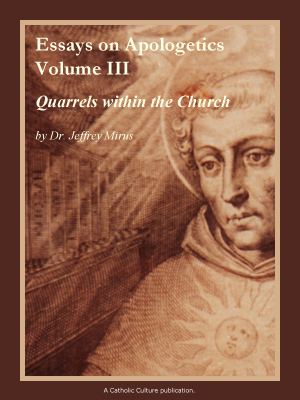Scripture and the Receptive Soul:
Reading the Bible Right
By Dr. Jeff Mirus ( bio - articles - email ) | Sep 13, 2005
In my last two columns I attempted to demonstrate that Scripture retains its inherent dignity and usefulness for salvation only in the Church. Even within the Church, however, not all will read Scripture profitably. Some, as St. Peter warns, will twist it to their own destruction (2 Pet 3:16). To profit from the Word of God we have to approach it in the right way, and especially with the right disposition. Let’s review a few basic principles.
Disposition and Familiarity
The seminal work on reading Scripture is Augustine’s De Doctrina Christiana (On Christian Doctrine). In this treatise, Augustine sets out to discover what is to be understood in the reading of Scripture and how we are to teach what we have learned from Scripture. Four sections cover the proper disposition for reading, the understanding of literal and figurative signs, the rules of interpretation, and the proper disposition for teaching as well as the appropriate use of rhetoric. After over fifteen hundred years, this book remains indispensable.
Augustine rightly devotes the first quarter of this book to the disposition of the reader, arguing that the most important factor in understanding Scripture is to read it with charity. Referring to St. Paul’s first letter to the Corinthians, the great Church Father concludes that Scripture must be read “from a pure heart, and a good conscience, and an unfeigned faith” (1 Cor 13:13). Augustine also notes that it is very important to become thoroughly familiar with Scripture before going very far in attempting to interpret it. One accomplishes this first and foremost, he says, by reading Scripture frequently, eventually reading all of it, hopefully more than once.
Private and Public Readings
With the right disposition and a basic familiarity with the Word of God, one is prepared to humbly read the text, open to the promptings of the Holy Spirit and submissive to the rule of Faith as articulated by the Magisterium of the Church. Thus fortified, the reader will immediately distinguish between what he gains from Scripture privately or personally and what he ought to publicly assert about the text. For Scripture serves two (or at least two) purposes: it provides spiritual light and consolation for one’s personal life, and it is a source of public Revelation which must be accepted by all.
Those who read Scripture frequently will invariably experience this distinction firsthand. On a particular occasion, a reader may find a special passage which seems to speak directly to himself or to his own special needs, bringing light, consolation and peace. Yet he may return to the same passage only a few days later and wonder what he saw in it that affected him so powerfully. If we do not attempt to impose a single meaning on every text, this is not surprising. On the contrary, it is an example of the Holy Spirit at work, imparting a personal meaning to us and speaking to our souls in need.
Because Scripture works in this way, and because we are reading humbly and with the rule of Faith in mind, we are not likely to go wrong in accepting the consolations the Spirit chooses to give us. But we would be very great fools indeed if, feeling touched by grace in a private need, we were to run off and attempt to teach others that what the Holy Spirit had in mind for us at that moment is the sole and definitive meaning of the text, which everyone must accept.
The Formal Meaning of the Text
To establish a formal or public meaning of the text is a considerably more rigorous process. The process begins with a study of all the relevant background: an examination of the possible meanings of the various words and figures of speech in the original language; an investigation into the historical and social background which influenced the human author and set the stage for his account; and perhaps even a discovery of the nature of particular buildings, arts, crafts, rituals, human relationships or other special topics which may be relevant.
The same must be done with other relevant passages which seem to address the same or similar points, throughout all the inspired books. It is a first rule of all textual interpretation that everything an author has said on a subject must be taken into account to represent his views fairly. This is infinitely more true of Scripture, all of which is inspired by the Holy Spirit, Who can neither make mistakes nor contradict Himself. Thus any interpretation of one passage must also satisfy the demands of all other passages which bear on the point. In other words, an interpretation must be found which is compatible with every relevant text.
But the Holy Spirit has inspired more than one source of revealed truth. Scripture’s twin in the work of Revelation is Tradition, and just as all the texts from the approved books of Scripture must be addressed, so too must all information that comes to us through the approved Tradition of the Church. Moreover, the Holy Spirit also protects the Magisterium of the Church (the formal teaching of faith or morals by the pope and the bishops in union with him). There is in fact a great coherence in all sources of truth inspired by God. Theologians call this the analogy of Faith.
What this means is that, to give the Holy Spirit His due, we must find an interpretation for our passage of Scripture which satisfies the demands not only of the rest of Scripture, but of Tradition and the Magisterium of the Church. Again, a meaning must be found which is compatible with all statements from all three sources which bear upon the same point. Indeed, it is not infrequent that something in Tradition will clarify an obscurity in Scripture by giving us a separate source of knowledge on the topic in question. Moreover, precisely because the Magisterium typically directs its teachings to controversial points, we can often find in its statements precisely the information we need to make something clear. By proceeding in this way, we will have learned something both true and useful—and something that we may teach with confidence to others.
Inexhaustible Riches
Nonetheless, we will not have exhausted the riches of Scripture, which often has multiple layers of meaning. Much that is reported of Moses and the Exodus has not only a literal meaning for that time in Jewish history but a typological meaning pointing forward to Christ and the Redemption. In fact, not a few Scripture passages have several layers of meaning—literal, prophetic, moral, and typical of either the New Covenant or the heavenly kingdom, or both. Prophecies too are capable of multiple fulfillment, in Old Testament history, again in Christ’s time, and perhaps even again in our own moral lives.
Indeed, the riches of Scripture are so great that the chief sin by which one twists it to destruction is the sin of presumption, the sin of attempting to exhaust its meaning by imposing one’s own will upon it. Those who read with a pure heart, a good conscience and an unfeigned faith will not be guilty of such presumption. They will be attentive to God’s authority in all its forms, and will never believe that, by themselves, they can plumb His boundless depths.
All comments are moderated. To lighten our editing burden, only current donors are allowed to Sound Off. If you are a current donor, log in to see the comment form; otherwise please support our work, and Sound Off!








